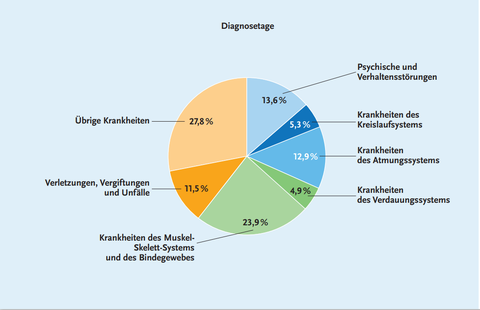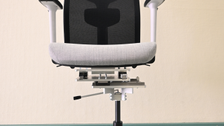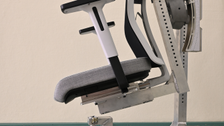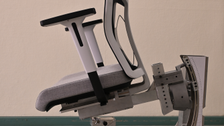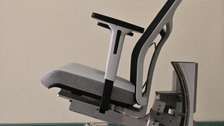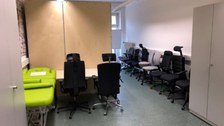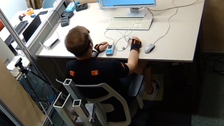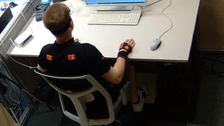Own Personal Care (OPC)
Investigation of the physical and psychological effects of seated movements during office work at the Chair of Ergonomics, TU Dresden
Project description
More and more people are spending most of their free time and working hours in a seated posture. According to the Federal Institute for Occupational Safety and Health [BAuA], the advancing digitalization and the trend towards mobile work can be identified as the cause (BAuA, 2020). According to a study by the Industrieverband Büro und Arbeitswelt [IBA], 59% of all employees in Germany spend more than half of their working hours at an office workstation and therefore predominantly sitting down (IBA, 2020, p. 6). Developments over the last ten years suggest that these figures will continue to rise. For example, the number of desk jobs increased by 16% between 2006 and 2016 (Krüger, L. 2021). Static sitting for many hours continues to be a common practice in office work. This can result in musculoskeletal disorders and mental illnesses, which can be identified as the main causes of incapacity for work (as at 2019). Office workers sit for many hours a day and are therefore particularly at risk (Hadgraft et al. 2016). To prevent this, sedentary people are often required to move more in the form of walking and changing posture and strain. So-called dynamic and 3D office chairs have a different pivot point depending on their mechanism and therefore generate a different type of movement for the user. For this reason, the Own Personal Care [OPC] project is investigating which mechanism simulates a natural movement of the hips, how much inclination of the seat surface is beneficial and at what frequency the user should move while sitting. This serves the overarching goal of finding preventative measures.
- Physical complaints due to prolonged static sitting. These include
- Damage to the spine and intervertebral discs. The intervertebral discs can be undersupplied due to a lack of load changes. This can lead to herniated discs.
- Degeneration due to underload
- Consequential diseases of the cardiovascular system
- Metabolic diseases such as type 2 diabetes can also result from excessive sitting.
- Mental illnesses
- The body is metabolically understressed during sedentary activities. This can lead to local and systemic metabolic adaptations
- Excessive strain due to forced postures leads to tension.
- Staff absences
- Costs due to sick days
- Ethical responsibility
Diagnostic days by type of illness
Half of all diagnosis days can be attributed to illnesses caused by excessive sitting (Suga 2019). In addition to musculoskeletal disorders, these include mental and behavioral disorders as well as diseases of the respiratory system (Suga 2019). The World Health Organization (WHO) already recommends limiting daily sitting time in a targeted manner (WHO, 2020), while the BAuA sees the greatest prevention potential for musculoskeletal diseases (BAuA 2021).
Absenteeism costs by type of illness
Musculoskeletal disorders have the greatest potential for prevention (Suga 2019). Incapacity to work due to illnesses in this category causes annual production losses of 19.5 billion euros and a loss of gross value added of 33.2 billion euros in Germany alone.
Previous findings on alternative office workstations
- Dynamic workstations, such as combinations of treadmill and table or elliptical trainer and table, do not lead to any significant change in posture compared to conventional workstations (DGUV, IFA Report 4/2014, p.35)
-
If the use of dynamic workstations only leads to a slight increase in muscular activity, there is nevertheless a significant increase in physical activity, heart rate and energy expenditure. (DGUV, IFA Report 4/2014, p.35)
-
Slight changes in posture, resulting in less muscular activity, can therefore still be regarded as beneficial to health. (DGUV, IFA Report 4/2014, p.35)
In principle, most employees are interested in using dynamic office workstations. However, the actual usage behavior depends largely on the individual and subjectively perceived working conditions.
-
Positive effects on the work process are predominantly described
-
Users associate working at dynamic workstations with positive feelings or moods
-
After frequent use (at least three times a week), there is a positive effect on general well-being.
-
During use, there can be positive developments in self-confidence, mood, willingness to exert effort and relaxation. Recovery is of particular importance, as it can compensate for previous stressful situations (DGUV, IFA Report 3/2018, p. 44)
(DGUV, IFA Report 3/2018, p. 43)
What is currently missing?
- Findings on which dynamic/3D office chairs are actually useful from a physiological perspective
- Findings on how much ° inclination of the seat surface a dynamic/3D office chair should allow
- Findings on how quickly and frequently people should move while sitting
- Insights into how long the break time should be for muscle regeneration and pulse rate to prevent fatigue
- Specific guidance for managers and office workers on the frequency and type of movements to maximize impact
- Definition of guidelines for managers to ensure the long-term well-being of the workforce
- Identification of:
- Technical design approaches
- Optimal frequency/number of movement changes
- Effects on physical and mental capabilities and concentration
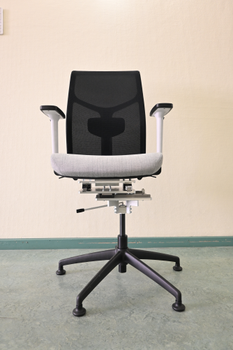
© Mark Bührer, 2022
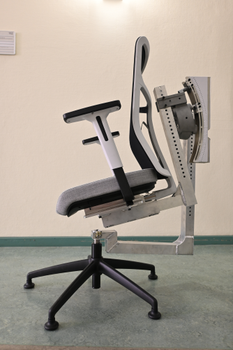
© Mark Bührer, 2022
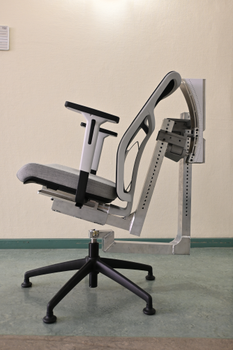
© Mark Bührer, 2022
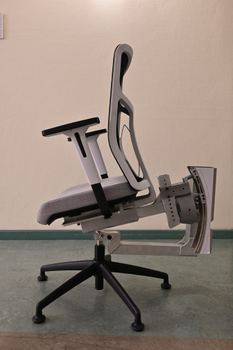
© Mark Bührer, 2022
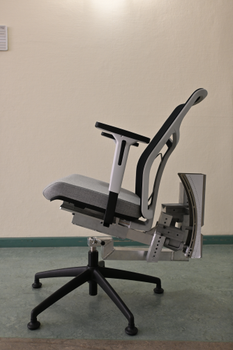
© Mark Bührer, 2022
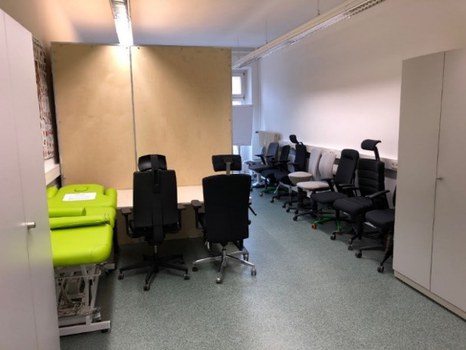
© Mark Bührer, 2022
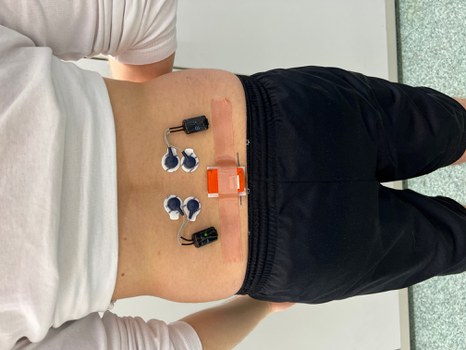
© Mark Bührer, 2022
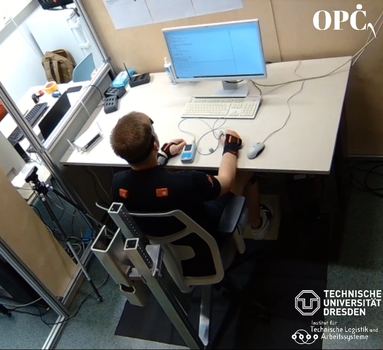
© Mark Bührer, 2022
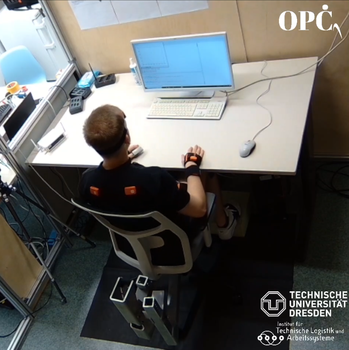
© Mark Bührer, 2022
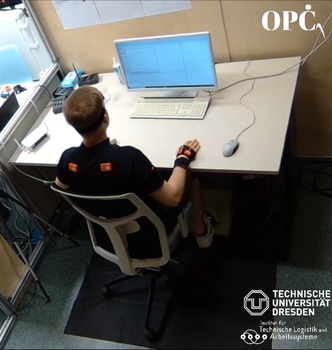
© Mark Bührer, 2022
Studies as part of the Own Personal Care project
- Technical review of physically advantageous degrees of freedom
- Which office chair mechanism (considering individual degrees of freedom) supports the user's physiology and promotes natural movements?
- Which mechanism is suitable for office use?
- Which mechanism encourages the test subjects to change movement and how much freedom of movement is used?
- Effects of static sitting
- Comparison of static sitting through measurements on a conventional office chair
- Measured values using electromyography (EMG), motion capturing, seat tilt sensors, salivary cortisol measurement, as well as values from questionnaires on well-being, concentration and capabilities form the basis for future objective interpretations
- Optimum tilt angle
- The movement cycles are examined individually on special examination office chairs
- Degrees of freedom and tilt angles are varied
- The test subjects also rate their individual subjective perception on a scale
- Optimal value Number of load changes, their frequency and recovery time
- Based on the findings from the previous measurements, the frequencies between the load changes are now varied
- The muscle activity is measured and the test subjects are questioned again
- The subjective optimum value is at the limit with the highest possible muscle activity and the greatest possible acceptance. A physiological limit value is formed at the beginning of the detection of muscular fatigue and/or when the continuous performance limit of the pulse rate is exceeded
- Verification of the results in a further study based on the measured values from the previous tests using a control group for office work
Results
Study 1 as part of a diploma thesis, Seating discomfort: Reference values for optimum seat pressure distribution on office chairs : Poster Discomfort
Video Interview Own Personal Care Mark Bührer
MDR-SACHSENSPIEGEL Gesünder Sitzen TU-Dresden forscht an dynamischem Bürostuhl © MDR-SACHSENSPIEGEL
The project is funded by the Karl Schlecht Foundation
Sources:
Åsvold BO, Midthjell K, Krokstad S, Rangul V, Bauman A. Prolonged sitting may increase diabetes risk in physically inactive individuals: an 11 year follow-up of the HUNT Study, Norway. Diabetologia. 2017 May;60(5):830-835. doi: 10.1007/s00125-016-4193-z. Epub 2017 Jan 4. PMID: 28054097.
Atkin A, Gorely T, Clemes S, Yates T, Edwardson C, Brage S, Salmon J, Marshall S, Biddle S (2012) Methods of Measurement in epidemiology: Sedentary Behaviour, International Journal of Epidemiology, Volume 41, Issue 5, October 2012, Pages 1460–1471, https://doi.org/10.1093/ije/dys118
Bates LC, Alansare A, Gibbs BB, Hanson ED, Stoner L. Effects of Acute Prolonged Sitting and Interrupting Prolonged Sitting on Heart Rate Variability and Heart Rate in Adults: A Meta-Analysis. Front Physiol. 2021 May 3;12:664628. doi: 10.3389/fphys.2021.664628. PMID: 34012409; PMCID: PMC8126673.
BAuA (2020). Bewegung fördern und langes Sitzen am Arbeitsplatz vermeiden. Workshop Gesundheitsgefährdung durch langes Sitzen am Arbeitsplatz dokumentiert. Bundesanstalt für Arbeitsschutz und Arbeitsmedizin. Zugriff am: 13.07.2021. Verfügbar unter: https://www.baua.de/DE/Angebote/Aktuelles/Meldungen/2020/2020-07-31-Langes-Sitzen-am-Arbeitsplatz.html
BAuA-Bundesanstalt für Arbeitsschutz und Arbeitsmedizin (2021) Arbeitswelt im Wandel – Zahlen Daten Fakten. 1. Auflage, Mai 2021, ISBN 978-3-88261-737-5 (Print) doi:10.21934/baua:praxis20210304
DGUV, IFA Report 4/2014, p.35
DGUV, IFA Report 3/2018, p. 44
DGUV, IFA Report 3/2018, p. 43
Hadgraft N, Healy G, Owen N, Winkler E, Lynch B, Sethi P, Eakin E, Moodie M, LaMontagne A, Wiesner G, Willenberg L, Dunstan D (2016) Office workers' objectively assessed total and prolonged sitting time: Individual-level correlates and worksite variations. Preventive Medicine Reports Vol. 4
Hamilton M, Hamilton D, Zderic T (2007) Role of Low Energy Expenditure and Sitting in Obesity, Metabolic Syndrome, Type 2 Diabetes, and Cardiovascular Disease. DIABETES, Vol. 56
Industrieverband Büro und Arbeitswelt e.V. [IBA] (2020). IBA-Studie 2019/20. Wiesbaden S.6
Kilpatrick M, Sanderson K, Blizzard L, Teale B, Venn, A (2013) Cross-sectional associations between sitting at work and psychological distress: Reducing sitting time may benefit mental health, Mental Health and Physical Activity Volume 6, Issue 2, 2013, Pages 103-109, ISSN 1755-2966, doi.org/10.1016/j.mhpa.2013.06.004.
Kingma I, van Dieën J. Static and dynamic postural loadings during computer work in females: Sitting on an office chair versus sitting on an exercise ball; https://doi.org/10.1016/j.apergo.2008.04.004
Krüger, L.: Wer länger sitzt, ist früher tot. In: Zeit Arbeit 2021
Pope M, Goh KL, Magnusson M (2002) Spine Ergonomics, Annual Review of Biomedical Engineering. Annu. Rev. Biomed. Eng. 2002. 4:49–68, doi: 10.1146/annurev.bioeng.4.092101.122107
Uffelen, J, Gellecum Y, Burton N, Peeters, G, Heesch, K, Brown, W (2013). Sitting-Time, Physical Activity, and Depressive Symptoms in Mid-Aged Women. American journal of preventive medicine. 45. 276-81. 10.1016/j.amepre.2013.04.009.
WHO, World Helath Organisation (2020) guidelines on physical activity and sedentary behaviour. Geneva: World Health Organization; 2020.Licence: CC BY-NC-SA 3.0 IGO.


